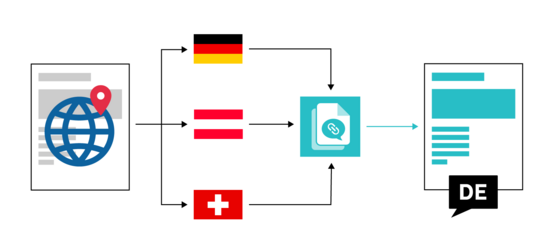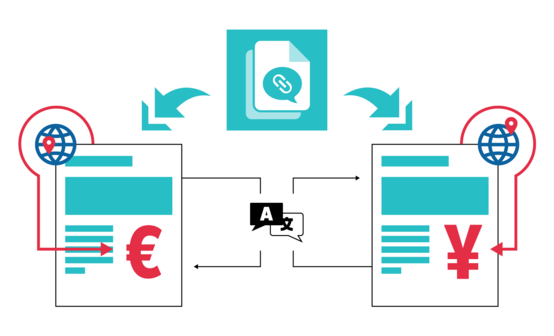Help us create more sophisticated multilingual page trees for TYPO3
b13’s extension proposes a new way forward

Global organizations need to speak to as many customers as possible in their native language. With its out-of-the-box multi-site and multilingual capabilities, TYPO3 excels at creating different language versions of the same content to reach everyone an organization needs to. Organizations with multi-tree installations, however, need an alternative solution that TYPO3 Core cannot accommodate. b13 has a proposed solution to fill in this gap and we want your input.
TYPO3’s out-of-the-box solution
TYPO3 automatically generates HTML snippets (called hreflang tags) to link different multilingual or regional versions of the same page. The hreflang tags help Google (or other search engines) show the right content for users of a certain region, geography, or language; Germany-based users will get a different version of the page from France-based users, as we show below.
1
2
<link rel="alternate" hreflang="de" href="https://www.example.com/de/" />
<link rel="alternate" hreflang="fr" href="https://www.example.com/fr/" />
Many organizations break it down even more granularly; they create different versions of a language for a particular region – like an Australian English page and a Great Britain English page.
1
2
<link rel="alternate" hreflang="en-AU" href="https://www.example.com/au/" />
<link rel="alternate" hreflang="en-GB" href="https://www.example.com/gb/" />
Even though these pages are both English, the hreflang tags clearly define the region they’re intended for.
In a single page-tree setup, TYPO3 saves both examples in the backend database as translated versions of the same page, thus these hreflang-tags can be created automatically. The hreflang tags inform Google or other search engines of the relationship between the translated pages, so it’s clear they are not duplicate content.
Unlinked pages can impact SEO
In the TYPO3 backend, organizations handle their multilingual needs in different ways. They can create a page tree for each language or group all their languages in one tree. Here’s where we run into the snag: pages can only be automatically linked if they are in the same page tree. Any other configuration means it’s impossible for any system, including TYPO3, to know which pages from other page trees are intended to be the same content for other regions or languages. Many organizations have a multilingual setup that already uses multiple page trees, and these pages with multilingual versions remain unlinked.
An organization may also have different regional websites intended solely for that region. For example, a website for Spain with Spanish and English version content may also have a South American website with Spanish, English, and Portuguese translated content. There’s no way for the TYPO3 backend to tell which of these are the same content, so they also cannot be linked.
In both cases, these missing links spell trouble with Google. Since the search engine can’t tell the relationship between the pages, it might treat them as duplicate content, which negatively impacts your SEO. Unfortunately, connecting these pages in the backend is not possible using TYPO3’s core features.
We’ve repeatedly run into this issue in client projects, especially for websites with dozens or hundreds of languages or regional pages. We propose an extension that will resolve this duplicate content issue for all impacted websites and projects.
The extension: making multi-tree setups and cross-site hreflang tags a reality
Our extension would enable both multi-tree multilingual setups and cross-site hreflang tags. With the proposed extension, we would link a group of pages that belong together (like an English page with German and Spanish translated versions) to another page tree in the same TYPO3 instance that feature the same content for a different region, for example, a US version with English and Spanish.
We would link the EN version of page tree 1 with the default language (probably EN in page tree 2 for the US) and make sure that the resulting pages for page tree 1 and 2 are linked in all directions. The resulting "hreflang page set" would contain these regions/language versions:
- US-EN
- US-ES
- EN
- DE
- ES
Within the linking of these two pages, the editor defines the “global default,” which will be added as a default-x tag across all pages linked.
In addition, there are other potential benefits the extension could include, such as:
- Enhanced sitemap — A sitemap with all your different languages included
- User restrictions — Give regional roles permission to edit or link their page, but not others (for example, editors in Spain cannot change the Russian page, only their own)
Have a multilingual site affected by this issue? You can help.
With our outlined extension, organizations that need a page tree for each language, region, and country could all be accommodated in a linked, multi-tree setup. The greater sophistication of this extension would more closely fit a greater variety of sites’ needs and remove the SEO burden of duplicate content.
If you have a multilingual TYPO3 site, you may be unknowingly impacted by this issue. The good news is, you can be part of the solution! We're currently looking for helpers willing to chip in to make this a new, single-purpose, highly flexible, free, open source extension for TYPO3 a reality for everyone.
Would this extension help your multilingual use case?




